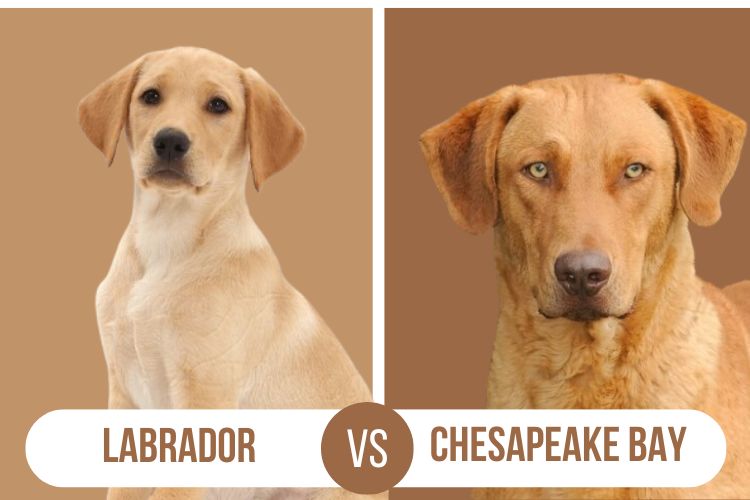Are you trying to decide between a Labrador Retriever and a Chesapeake Bay Retriever? These two popular retriever breeds are known for their loyalty, intelligence, and hunting abilities, but they also have distinct differences. In this article, we’ll dive into a detailed comparison of these breeds, helping you make an informed decision on which retriever is right for your family or lifestyle. Whether you’re an avid hunter or looking for a family pet, this comprehensive guide is worth reading.
Breed Characteristics
Both the Labrador Retriever and the Chesapeake Bay Retriever are medium-sized dogs, but their physical characteristics are notably different. Uncover the unique traits of popular crossbreeds like the Brindle Black Mouth Cur Pit Mix and see what makes them stand out!
Labrador Retriever
The Labrador Retriever is known for its short, dense coat that comes in three distinct colors: black, yellow, and chocolate. Labradors tend to have a sturdy yet slightly leaner build compared to other retrievers. If you’re looking to add a Labrador to your family, it’s essential to find a good breeder who prioritizes the health and temperament of each to ensure you get a well-bred dog with the best characteristics.
Chesapeake Bay Retriever
The Chesapeake Bay Retriever dog, or Chessie, on the other hand, sports a thicker, wavy coat that’s waterproof and slightly oily. This breed is built for endurance and toughness, often looking more muscular than the Labrador. Both dogs fall within similar height and weight ranges, but their coat texture and body build can help you distinguish between them. When considering a breed comparison, if you’re looking for a great dog to withstand harsh weather conditions, the Chesapeake Bay coat might give it the edge
You May Interested in: Comparison Between Black Lab vs Yellow Lab Comparison
Personality and Trainability
One of the key differences between these two breeds lies in their temperament. The Labrador Retriever is renowned for its friendly and outgoing nature. It’s a breed that loves to please, making it an ideal choice for families, including first-time dog owners. Labs are known to get along well with children and other pets, and their eagerness to be part of family activities is one of the reasons they’re among the most popular dog breeds.
The Chesapeake Bay Retriever vs the Labrador Retriever tends to have a more independent and sometimes dominant personality. While they’re just as loyal as Labradors, Chessies are known to be more protective, making them excellent guard dogs. However, this protective instinct means they require more consistent and intense training. Training a Chessie can be more challenging than a Labrador, so if you’re a novice dog owner, the Lab might be easier to train. For experienced dog owners, the Chesapeake Bay Retriever can be a great companion, especially if you’re looking for a dog with hunting instincts.
Exercise and Activity Needs
Both retriever breeds are high-energy dogs, requiring at least 60 minutes of vigorous exercise daily. Whether it’s swimming, running, or retrieving, both the Labrador and Chesapeake Bay need plenty of physical activity to stay healthy and happy.
Labradors are generally more food-motivated, which can make training easier, but also means you’ll need to monitor their treatment intake to avoid obesity. If you’re interested in duck hunting, a Lab is a great choice, as their love for swimming and retrieving makes them an ideal duck dog. If you want a dog that loves to play fetch and swim, a Lab is a great option, but be mindful of their weight.
The Chesapeake Bay Retriever is more independent and needs mental stimulation in addition to physical exercise to prevent boredom. Chessies are often less eager to please than Labs, which is why structured activities like hunting dogs or retrieving tasks are particularly important. If you’re a duck hunter or participate in hunt tests, Chessies may suit your lifestyle perfectly.
Here Is another comparison between Chocolate Lab vs Black Lab Must Read It:
Health and Care
Like many large dog breeds, both the Labrador Retriever and the Chesapeake Bay Retriever are prone to certain health conditions.
Both breeds can suffer from elbow and hip dysplasia, so regular vet checkups and preventative measures like proper diet and exercise are crucial. DNA testing for conditions like Exercise-Induced Collapse (EIC) is also recommended for both Labradors and Chessies.
However, the Chesapeake Bay Retriever is also more prone to conditions like Progressive Retinal Atrophy (PRA) and Degenerative Myelopathy, which can affect their eyes and spine. Owners should take extra precautions to regularly check their dog’s vision and overall mobility.
Grooming is essential for both breeds, but the Chesapeake Bay’s oily, waterproof coat requires more regular maintenance than the Labrador’s smooth fur. Keeping their coats clean and healthy will help prevent skin issues and discomfort.
Living Situation and Family Dynamics
If you’re looking for a family dog, the Labrador Retriever is an excellent choice. Labs are known for their gentle nature, making them a great option for families with young children. They tend to be patient and affectionate, qualities that make them a favorite as a service dog or therapy animal.
The Chesapeake Bay Retriever, due to its protective nature, might be better suited for families with older children or individuals who appreciate a more alert and watchful dog. Chessies can be slightly territorial, which means they may not be as laid-back around strangers or smaller children as Labs. However, with proper socialization, they can become wonderful family pets.
Both breeds are social dogs that thrive on interaction, so they’re not ideal for people who are away from home for long periods.
Grooming and Maintenance
Grooming routines differ between these two breeds. Labradors typically require brushing two to three times per week to keep their coats shiny and healthy. Due to their shorter coat, Labs tend to be easier to groom. Regular nail trimming, ear cleaning, and dental care are essential for both breeds, especially if they spend time outdoors.
The Chesapeake Bay Retriever requires daily brushing to keep its thick, wavy coat manageable. Their oily coat helps protect them during water activities, but they can get dirty more easily. Unlike Labradors, Chessies require less frequent bathing, but when they do need a bath, special attention should be paid to cleaning their coat properly to avoid any buildup of oils.
Final Thoughts
Both the Labrador Retriever and Chesapeake Bay Retriever are wonderful, loyal companions, but they’re suited to different types of families and lifestyles. If you’re looking for an easy-going, food-driven family pet, the Labrador might be your best bet. On the other hand, if you need a protective, independent hunting companion, the Chesapeake Bay Retriever could be a better fit.
FAQs
Here are some questions that are mostly asked about the comparison between Labrador vs Chesapeake Bay Retriever,
Are Labradors or Chesapeake Bay Retrievers healthier?
Both breeds are generally healthy but have specific genetic predispositions. Labradors tend to suffer from obesity and joint issues, while Chesapeake Bay Retrievers may experience thyroid and eye problems.
Which breed requires more grooming?
Chesapeake Bay Retrievers require more specialized grooming due to their oily, wavy coats, whereas Labradors have simpler grooming needs.
What are the key differences in lifespan between Labradors and Chesapeake Bay Retrievers?
Labradors typically live 10-12 years, while Chesapeake Bay Retrievers have a slightly shorter lifespan of 10-11 years.
Which breed is better for families with kids?
Labradors are typically more social and patient, making them great family dogs. Chesapeake Bay Retrievers can be good with kids but are more independent.
How much exercise do Chesapeake Bay Retrievers need compared to the Labradors?
Both breeds need significant exercise, but Chessies often require more mental stimulation due to their working dog heritage.







